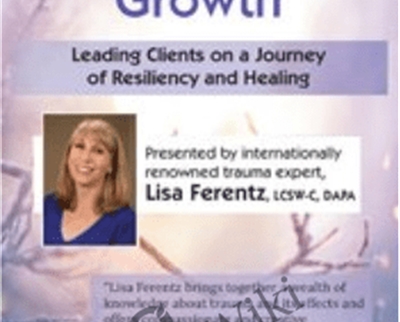Post-Traumatic Growth: Leading Clients on a Journey of Resiliency and Healing with Lisa Ferentz, LCSW- C, DAPA – Lisa Ferentz
 Become empowered as a trauma clinician! Learn from expert trauma clinician Lisa Ferentz how to shine a spotlight on your clients’ resiliency and creativity
Become empowered as a trauma clinician! Learn from expert trauma clinician Lisa Ferentz how to shine a spotlight on your clients’ resiliency and creativity
Post-Traumatic Growth: Leading Clients on a Journey of Resiliency and Healing with Lisa Ferentz, LCSW- C, DAPA by Lisa Ferentz,
Salepage link: At HERE. Archive:
Become empowered as a trauma clinician! Learn from expert trauma clinician Lisa Ferentz how to shine a spotlight on your clients’ resiliency and creativity – while planting the seeds of hope and Post-Traumatic Growth even in the earliest stages of therapy!
When we work with traumatized clients we often feel compelled to stay focused on the inevitable byproducts of PTSD. As we look for the ways in which clients have been adversely affected by their trauma, it can inadvertently narrow our sense of who they are, and solidify their identities as “damaged” or “broken.”
Although helping clients to reconnect with and process their pain and grief is important, this workshop takes you further.
You will learn respectful and powerful ways to weave the concepts of Post-Traumatic Growth into the treatment process.
Using moving and inspiring case examples and videos made by clients we will identify the tangible markers of post-traumatic growth including:
- a new way of relating to others
- the capacity to believe in new possibilities
- the rediscovery of personal strengths
- a newfound appreciation for life
Participants will have many opportunities to practice creative strategies including: somatic resourcing; journaling; drawing; two – handed writing; and guided imagery and visualizations all designed to install and strengthen hope, growth, and healing in clients and therapists alike.
- Characterize post-traumatic growth and identify two metaphors that can be used to introduce the concept into the therapy process.
- Construct three examples of how the meaning clients attach to trauma can either intensify or mitigate their experiences.
- Evaluate three examples of the positive and negative impact that clients’ meaning-making has on treatment outcomes.
- Analyze at least three reasons why some clients might find it challenging to reach a place of post-traumatic growth.
- Assess for 5 personality traits that can increase the likelihood of clients experiencing post-traumatic growth in therapy.
- Communicate the “hamster wheel” phenomenon of perpetually asking “why” trauma occurred.
- Construct the cognitive steps that allow trauma survivors to move beyond their questioning into pro-active, forward movement.
- Appraise the “Shattered Vase” analogy and its relevance to posttraumatic growth.
- Choose three ways in which the strengths- based perspective can be woven into treatment and how why it benefits client’s healing processes.
- Select three assessment questions that can be used to highlight and strengthen clients’ resiliency.
- Categorize the 5 measurable arenas that are indicative of posttraumatic growth and give examples of each.
- Implement at least 6 creative strategies designed to connect clients to the concepts of PTG and to strengthen their awareness of their own growth journeys.
PROCESSING THE IMPACT OF TRAUMA
- Shifting from PTSD to Posttraumatic Growth (PTG)
- Define PTG- analogies for treatment
- Explore the Subjective Meaning of Trauma
- Writing Experiential
ASSESS FOR CLIENT RESILIENCY
- The Challenges of Achieving PTG
- Planting the Seeds of PTG in Therapy
- The Therapist’s Lens and Countertransference
- Case Study
THE POWER OF POSITIVE SELF-TALK
- The Strengths-based Perspective
- Introduce Self-Compassion
- Experiential: Remembered Resources
- Cognitive Re-framing: Going for Kindness
MOVE BEYOND A TRAUMA IDENTITY
- Notice Double Standards
- Highlighting Resiliency
- Indicators of Post-traumatic Growth
EXPLORING THE MANIFESTATIONS OF POSTTRAUMATIC GROWTH
- Process the PTG Inventory
- Re-discover Personal Strengths
- Case Study and Video
- Experientials: Somatic resourcing, Visualization and Art
- Belief in New Possibilities
- Case Study and Video
- Experiential: PTSD and PTG Through Art
MOVING BEYOND THE TRAUMATIZED SELF
- Relating to Others
- Experiential: Two-handed Writing
- Exploring Spirituality
- Case Study and Video
HELP CLIENTS PAY IT FORWARD
- Newfound Appreciation of Life
- Case Study
- Experiential: Art and Gratitude
- PTG and Forgiveness
BUILDING ON THE SEEDS OF POST-TRAUMATIC GROWTH
- Additional Creative Strategies to Promote PTG
- Guided Imagery, Documenting Healing Through Artwork, Journaling